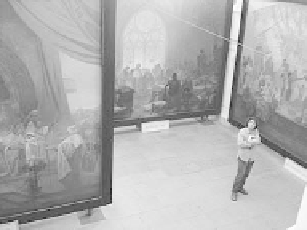Travel Reference
In-Depth Information
History of Mucha's
Slav Epic
Alfons Mucha (1860-1939), born in the nearby town of
Ivančice, made a hugely successful commercial career for
himself in Paris and in the US as
the
Art Nouveau poster artist
and illustrator. In Paris, Mucha conceived the idea of dedicat-
ing the second half of his life to a work that would edify his
nation. Throughout history, bards in every culture have com-
posed poems eulogizing the best moments of their tradition.
Mucha would do the same for the Czechs and the Slavs, on a
grand, epic scale...and on canvas.
Mucha convinced the Chicago industrialist Charles Crane
to sponsor his project. Both men believed that the purpose
of a truly patriotic work was
to inspire human beings to
understand one another bet-
ter, and thereby bring human-
ity closer together. Mucha
returned home, and by 1912,
finished the first three paint-
ings (each 25 by 20 feet). It
took another 16 years before
Mucha could dedicate the
cycle of 20 enormous can-
vases to the Czech nation
and the city of Prague. The response of his fellow artists was
lukewarm—in the experimental age of Picasso, Mucha's slinky
style and overt nationalism were out of fashion.
During the war, the patriotic work was hidden from the
Nazis and became damaged in the process. After years of
restoration, the paintings were unveiled in 1963 in Moravský
Krumlov's castle, near Mucha's birthplace.
politicized 19th century. A brilliant craftsman and designer,
Mucha captures the viewer's attention with his strong composi-
tion and sense of color. Like any true artistic masterpiece, Mucha's
work goes beyond the style of the time, beyond Art Nouveau,
beyond Slavic.
Consider contemplating Mucha's canvases on three levels.
First, with the help of the handout that you'll get at the ticket
office, decipher the history. The great feast is the celebration of
the Slavic pagan god, the zealous preacher is Jan Hus (the revo-
lutionary Czech priest), and the subdued old man contemplating
the dark horizon is the first Czech exile and great educator, John
Amos Comenius (for more about Comenius, see sidebar on page
236). Red is the color of war; white is the color of peace; blue is the
past; and orange is the future.
When you get tired of being told what's what, step back and





















